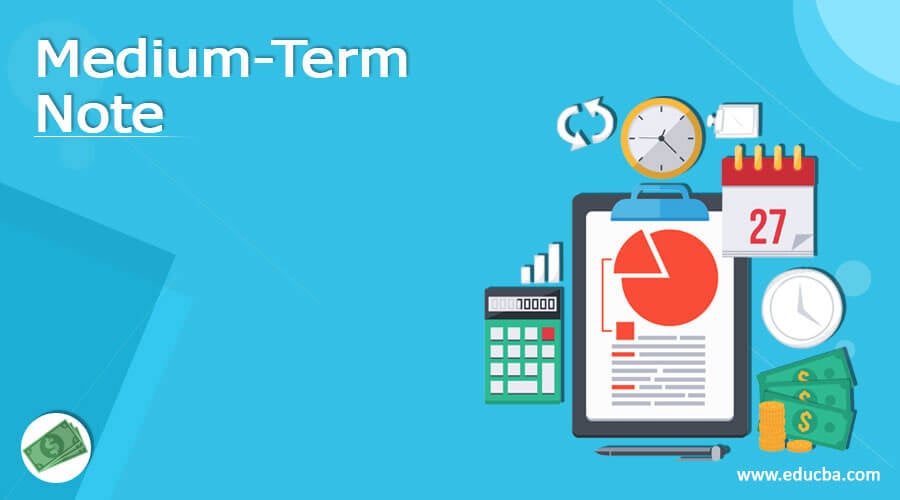Updated July 10, 2023
What is a Medium-Term Note?
“Medium-term note” refers to debt securities that mature in 5 to 10 years. Medium-Term notes allow companies to issue debt securities regularly.
Although most medium-term notes have a maturity of 1 to 10 years, companies can continuously issue corporate medium-term notes through a dealer for up to 30 years. In the case of corporate medium-term notes, the investors can choose from differing maturities, ranging from 9 months to 30 years.
How Does Medium-Term Note Work?
Typically, an issuer posts medium-term notes through selling agents offering rates over various maturities, such as nine months to 12 months, 12 months to 18 months, 18 months to 24 months, and annually after that. Medium-term notes can fix or float their interest rates, which they express as a yield spread over LIBOR, EURIBOR, and Treasury securities with comparable maturities. The selling agents usually disseminate this information to the investors and regional dealers. The selling agent interested in the notes offering approaches the issuer to confirm the transaction terms. Then the investor may select the maturity that suits their requirement, subject to a final agreement by the issuer.
Examples of Medium-Term Note
The following are some of real-life examples of medium-term notes.
Example #1
On 9th Nov 2020, Freddie Mac issued variable-rate medium-term notes worth $1 billion. The medium-term notes will bear a variable interest of 6.5 basis points spread over the Secured Overnight Funding Rate (SOFR) and will mature on 9th Nov 2022. The denomination per note is $1,000 and multiples thereof. The interest will be paid quarterly, and the first payment will start on 9th Feb 2021. After that, the interest payment will be made on the 9th day of February, May, August, and November until maturity. The underwriter for the issue is Barclays Capital. Since the notes are issued in the US, they are known as US Medium-Term Notes.
Example #2
On 14th Sep 2020, Banco Latinoamericano de Comercio Exterior, S.A., offered fixed-rate medium-term notes valued at $4 billion. The notes will bear an interest rate of 2.25% and mature on 14th Sep 2025. The interest will be paid half-yearly on the 14th day of Mar and Sep, commencing from the 14th Mar 2021.
The bank has a Moody rating of Baa2 and an S&P rating of BBB, which indicates that the medium-term notes have a moderate level of credit risk. In other words, the bank’s default risk is relatively lower in this case. The underwriters for the issue are BofA Securities, Mizuho Securities, and SMBC Nikko. Since it is a Panama-based bank, the notes are issued as Euro Medium-Term Notes.
Example #3
In Aug 2008, Lehman Brothers issued medium-term notes in denominations of $1,000 and linked to the performance of the S&P 500 stock index. The then 4th largest investment bank in the US promised uncapped growth potential and 100% principal protection. However, the entity declared bankruptcy one month later, in Sep 2008. Lehman Brothers’ creditworthiness largely backed the principal protection, and the brochure did not capture any default risk. After the default, the notes traded for 10-55 cents in the secondary market.
How Long is the Maturity Period of a Medium-Term Note?
Traditionally, medium-term notes fill the financing gap between short-term commercial papers with maturities of less than nine months and long-term debt of more than 30 years. Typically, medium-term notes have maturities between 2 to 5 years. However, companies usually issue short-term and long-term securities under a medium-term note program.
Advantages of Medium-Term Note
Some of the major advantages of medium-term notes are as follows:
- First, the rate of return offered by medium-term notes is higher than other investments of similar maturities.
- It allows investors to put money in securities with differing maturities, ranging between short-term and long-term options.
- It allows issuers to venture into diversified markets with many structured financial products.
- In the case of callable medium-term notes, the issuers can take advantage of the lower rate in the market by retiring the notes before their maturities and issuing them at the lower rate.
Disadvantages of Medium-Term Note
Some of the major disadvantages of medium-term notes are as follows:
- First, the servicing costs of medium-term notes are incremental, and thus they can potentially offset the savings made from interest payments.
- The issuance of medium-term notes in the US follows stringent documentation; hence, the issuers prefer issuing public bonds over multiple medium-term notes.
Key Takeaways
Some of the key takeaways of the article are:
- Medium-term notes refer to debt securities ranging from 5 to 10 years. However, they are issued continuously over some time with varying maturities, ranging from 9 months up to 30 years.
- Dealers handle the medium-term note issuances on behalf of the issuers.
- These notes bear interest that can be fixed or floating coupon rates. The variable rates are linked to benchmarks, such as LIBOR, EURIBOR, etc.
Conclusion
So, medium-term notes plug the gap between short-term financing and long-term debt. Effectively, investors can look beyond short-term investments but can escape the commitments associated with long-term investments.
Recommended Articles
This is a guide to Medium-Term Notes. We also discuss the definition, working, examples, advantages, and disadvantages. You may also have a look at the following articles to learn more –



